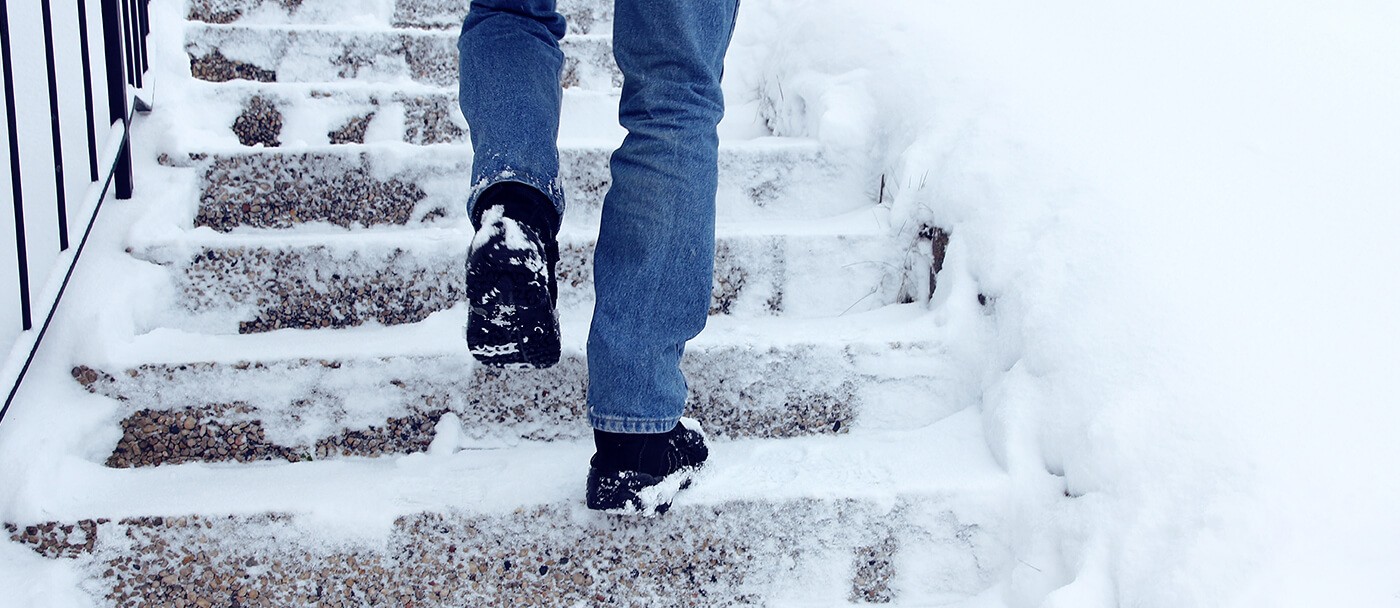Avoiding Slips and falls During the Winter

Canadian winters can present conditions that enable slip and fall injuries. Consider that icy surfaces are the cause of thousands of human injuries each year. Most falls happen at home, and last year in Canada, over 114,000 falls occurred at home that resulted in ER visits. Falls on ice were the cause of almost 8,800 serious injuries.
Common injuries include bruises, sprains or more serious injuries like broken bones or concussions.
The primary culprit is ice which can be invisible in the form of “black ice”. Snow can also add to slippery conditions, either by hiding icy patches underneath or becoming compacted and slick. Melting snow can freeze overnight, forming a thin layer of ice that is hard to see.
Tips to Avoid Injury
1. Footwear
Truly, the most obvious tip is wearing non-slip footwear. Those shoes with flat soles may be perfect for inside on dry surfaces, but not for suggested for outside when the surfaces are wet or slippery. Choose winter footwear with non-slip soles, deep treads and wide low heels. You can also buy special items like shoes grips or ice cleats that can be attached to give you extra traction. If you use a cane, you can get an ice pick tip for it.
2. Walk slowly
Plan your time so that you aren’t in a rush when you walk on slippery surfaces. Walk with small steps, pointing your toes out slightly to be more stable on icy paths. If conditions are extra slippery, try shuffling in a gliding-type motion. Some people carry a tiny container of sand or cat litter to provide them with traction in areas that are too hazardous.
3. Step down not out
Falls in parking lots are common. When you get out of your car, get in the habit of swinging both feet out instead of one, and placing them flat on the ground. The same goes with curbs, step down with both feet before continuing walking.
4. Keeps your hands free
You must keep your hands out of your pockets. Wearing gloves will not only keep your hands warm in cold weather, but the free arms give you better balance. More importantly, by wearing gloves, you are freeing your hands to break any fall. In the spirit of free hands, instead of carrying bag or briefcase, consider using a backpack.
5. Pay attention
Look where you are walking, avoid patches that may look slippery. It’s not a good idea to be on your cell phone while walking on slippery surfaces. Watch for uneven surfaces on sidewalks and potholes in parking lots that can become trip hazards.
6. Make use of handrails
Maybe not needed in the summer for most people, but they are an asset for everyone in winter. Handrails are extremely important to use when going up and down stairs. If you are walking on a slope where there is no handrails, be extra careful.
7. Wach out for slippery floors indoors
Water and ice can be found in public building entryways during the winter. Just take a second to look down when you enter a building or store.
What You Can Do at Home to Prevent Falls
- Before winter, inspect and correct your walking areas for potential issues such as uneven sidewalk or driveway surfaces that can be trip spots, downspouts that flow water directly onto walkways and overhanging branches.
- Before each storm event, make sure that you apply a liquid ice melter/preventer on the surfaces. If you don’t have liquid ice melter, you can put down a thin layer granular ice melter. The idea is to prevent ice from bonding to your surface.
- Shovel snow before planning on going out. Accumulated snow if not cleared, can compact and harden to a slippery surface.
- Broadcast a light layer of ice melter on the shovelled steps, walks, and driveway.
- Make sure that you have proper lighting in your outdoor areas.
What To Do If You Fall
Although most winter falls lead to minor bruises and injuries, sometimes you can tear a muscle or break a bone. While our older population is more at risk to injuries, accidents still happen to younger people.
If you start to slip and fall, drop everything in your hands so that they are free to break your fall. Protect your head by tucking it forward if falling backwards.
After a fall, check yourself for injuries. It is recommended that if you can get up, do so by rolling over on your side and slowly pulling yourself up on all fours, looking for a sturdy object to use to steady yourself as you straighten up. If you are too hurt to get up, then call for help.
If you have severe pain, numbness or tingling, difficulty moving, or loss of balance and dizziness, then you need to go to an ER at a nearby hospital.
Understanding all the slip and fall risks is your first step in winter safety. Be mindful of where you step and don’t forget to seek medical attention following a serious fall.






